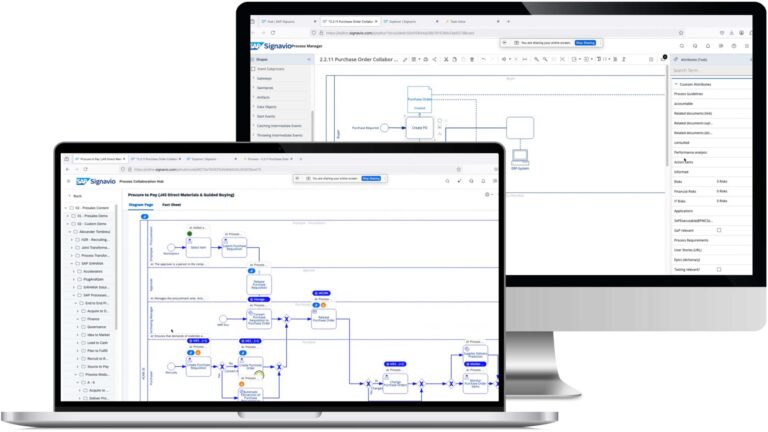
6 tips for increasing delivery reliability with batch size 1
Are you facing the challenge that your customers are demanding goods in ever smaller quantities?…

Blog
In times of dynamic markets, increasing regulatory requirements and growing expectations of efficiency and sustainability, the management of business processes is rapidly gaining in importance. Companies are under pressure to make faster and more informed decisions – and to do so on the basis of reliable data and clear process structures. This is exactly where SAP Signavio comes in: As a powerful suite for business process analysis, modeling and optimization, it offers companies an end-to-end tool for the continuous transformation of their business processes.
Those who do not actively manage processes today will lose competitiveness tomorrow. SAP Signavio creates the necessary platform, transparency and decision-making basis for a sustainable transformation.
Dr. Clemens Wolf, Manager Digital Operations
SAP Signavio is a cloud-based business process transformation suite that supports companies in analyzing, documenting, simulating and improving their processes. The solution was originally developed by Signavio, a start-up founded in Potsdam, and was acquired by SAP in 2021. Since then, it has been a central component of the SAP portfolio for business process management. What makes SAP Signavio so special is that the suite combines technical depth with an intuitive, collaborative user interface – connecting business departments, IT and decision-makers on a single platform.
Efficient process management fails in many companies due to a lack of transparency, fragmented system landscapes and a lack of coordination between specialist departments and IT. It is often unclear how processes actually work – especially across departmental or site boundaries. In many cases, IT-supported processes are characterized by media disruptions, redundant data and inconsistent system logic. In addition, processes often develop in an unplanned manner – without central control, clear roles or a uniform understanding of efficiency and compliance. While IT departments primarily view processes from a system perspective, there is often a lack of integration of business requirements and target images from the operational areas. The result: optimization potential remains unused and necessary changes do not take effect.
This is exactly where SAP Signavio comes in. The solution creates a uniform understanding across processes, visualizes the current status based on data and combines technical and functional perspectives. Governance mechanisms ensure that processes are not only designed, but can also be controlled, monitored and further developed in the long term. On this basis, decisions can be made that are not based on gut feeling, but on reliable data and concrete interdependencies – a crucial prerequisite for any successful transformation.
Non-transparent processes and isolated system environments are not technical problems – they are strategic risks.
Dr. Clemens Wolf, Manager Digital Operations
The SAP Signavio Suite is a modular platform for holistic process management. It combines tools for process modeling, analysis, control and improvement, thus enabling a seamless end-to-end view of company-wide processes. The individual modules can be flexibly combined and can be introduced step by step depending on the company’s level of maturity and objectives.
Process Manager – Making processes visible and understandable
The Process Manager is the heart of the suite. Processes are displayed as diagrams in the BPMN standard (Business Process Model and Notation) – like a digital flowchart. The special feature: Even employees without prior technical knowledge can intuitively record, comment on and further develop processes. This creates a common, comprehensible language between specialist departments and IT.
Process Intelligence – Analyzing processes on the basis of data
Process Intelligence is the suite’s process mining module. It uses real transaction data from IT systems such as SAP S/4HANA or other ERP solutions to show how processes actually run – including variants, loops, bottlenecks or rule deviations. This provides companies with data-based insights into efficiency, compliance and optimization potential.
Journey Modeler – connecting customer experiences with processes
The Journey Modeler can be used to depict business processes from the customer’s perspective. For example, it visualizes at which contact points friction or waiting times occur, how the process quality affects the customer experience and where improvements are particularly effective. In this way, process optimizations are consistently aligned with customer needs.
Process governance – establishing rules and responsibilities
Governance is an often underestimated success factor in process management. The module of the same name ensures that roles, responsibilities, approval processes and versioning are clearly regulated. It supports the creation of rules, audit trails and approval workflows – making process management audit-proof, transparent and controllable in the long term.
Collaboration Hub – Allow everyone to work on the same process image
The Collaboration Hub is the central portal for all employees in the company who are involved in processes – from IT to purchasing to sales. This is where everyone can access the current process models, provide feedback, ask questions,track changes and drive forward optimization and transformation. The hub promotes transparency, collaboration and shared understanding – a key success factor for functioning process management.

Whether S/4HANA migration, sustainability strategy or organizational change – many companies are currently facing far-reaching transformations. However, such changes often fail not because of the technology, but due to a lack of process clarity. Without a structured understanding of existing processes, it is difficult to successfully establish new systems and target states.
SAP Signavio provides precisely this missing link: the suite creates complete transparency across processes, supports data-based decisions and makes transformations plannable and controllable – instead of just managing them. Three particularly relevant application scenarios show how this works in practice:
1 S/4HANA transformation
The changeover to SAP S/4HANA is much more than an IT rollout – it opens up the opportunity for comprehensive process optimization. With SAP Signavio, companies can:
This approach is particularly effective when used in conjunction with LeanIX: while SAP Signavio creates transparency at process level, LeanIX enables the application and IT landscape to be mapped. Together, the two tools form a powerful foundation for taking a holistic view of process and IT structures, eliminating redundancies and strategically managing the S/4HANA transformation.
Effective processes are a decisive competitive factor in times of skills shortages, cost pressure and global uncertainty. SAP Signavio makes it possible to identify inefficient processes based on data – such as long throughput times, unnecessary loops or manual media breaks. End-to-end transparency makes these weak points visible and lays the foundation for targeted optimization.
3. sustainability and ESG
Sustainability goals and ESG requirements can only be implemented effectively if the underlying processes are clearly defined, measurable and controllable. SAP Signavio helps companies to identify ESG-relevant processes, integrate key figures and fulfill regulatory requirements in a structured manner. In this way, sustainability becomes part of operational excellence – instead of just reporting.
1. end-to-end transparency across the entire process lifecycle
SAP Signavio enables an end-to-end view of business processes – from as-is analysis and target modeling through to operational implementation and governance. This end-to-end view creates the basis for well-founded process decisions and reduces blind spots that often arise from individual departmental considerations.
2. objective analysis through realistic process data
Process Intelligence not only models processes, but also analyzes them on the basis of real transaction data (e.g. from SAP S/4HANA or other source systems). This enables the identification of process inefficiencies, lead time deviations, bottlenecks and automation potential – fact-based, objective and repeatable.
3. structured collaboration across functional boundaries
SAP Signavio promotes close integration between specialist departments, IT, governance functions and management. Processes are centrally documented, discussed and coordinated via the Collaboration Hub – including clear responsibilities and traceable histories. This creates a uniform understanding of processes throughout the company.
4. accelerated and controllable transformation
Thanks to its modular structure and methodical implementation, SAP Signavio supports a systematic transformation of the process landscape. Changes are not made ad hoc, but along a strategically coordinated roadmap – with clear priorities, quick wins and a sustainable governance model. This minimizes implementation risks and increases acceptance within the company.
5. seamless integration into the SAP system landscape
As part of the SAP Business Process Transformation portfolio, SAP Signavio can be fully integrated into existing SAP solutions. Process data from SAP systems is available for analysis, modeling and monitoring without any additional effort. This enables consistent data flows, automated KPI evaluations and a smooth connection to SAP S/4HANA transformation projects.
Success begins with clarity: A well-founded target image and a reliable comparison of the current situation make the difference between tool introduction and real transformation.
Dr. Clemens Wolf, Manager Digital Operations
The introduction of SAP Signavio is more than just the use of a new tool – it is a structured transformation process that combines functional, technical and organizational aspects. For companies, this means that they need a well-thought-out roadmap that takes into account both strategic objectives and operational requirements. This is precisely the decisive lever for management consultancies with technical expertise.
As experienced consulting partners, we support companies from the initial definition of objectives to the sustainable anchoring of process management in day-to-day business. A multi-stage process model has proven its worth here, enabling both quick wins and ensuring long-term scalability.
Before operational steps are taken, one central question must be clarified: What does the company want to achieve with SAP Signavio? Is it to prepare for an S/4HANA transformation, to introduce end-to-end process management, to increase transparency in value creation or to achieve measurable efficiency gains?
Our recommendation: In an initial strategy workshop, we work with your management and specialist departments to develop a target picture that includes the following aspects, among others:
The result: a jointly supported target image that serves as a guideline for all further activities – and which acts as a basis for decisions on the use of methods within SAP Signavio.
A common mistake during implementation is to start operations too quickly without a thorough analysis of the status quo. In order to derive the greatest benefit from SAP Signavio, a well-founded initial assessment should be carried out. We check this together:
Consulting services: We create a structured maturity report for process management in the company, evaluate the technical infrastructure (system landscape, data access, interfaces) and derive an individual implementation plan from this – including a “tool readiness check” for Signavio.
A successful start is best achieved with a clearly defined pilot project. Instead of involving the entire organization immediately, a specific process area is selected – for example, order-to-cash, procurement or complaints management. Instead of a comprehensive introduction from the outset, we rely on a targeted pilot approach – ideally in a business-critical but manageable process area. Typical entry points are, for example
Why piloting makes sense:
Our consulting approach: We design the pilot together, implement the necessary SAP Signavio modules (e.g. Process Intelligence and Process Manager), connect the relevant data sources and support the analysis and modeling phase. A structured project plan with a time frame, roles and responsibilities ensures implementation.
A key success criterion for SAP Signavio is organizational embedding. Processes do not change by themselves – they must be actively managed, maintained and further developed. Without change management, even the best analysis will fall flat.
Our approach includes:
Best practice: Together with our customers, we implement a continuous improvement process (CIP) based on the governance functions of SAP Signavio. This creates a dynamic process landscape that adapts to market changes.
A successful pilot is usually followed by successive expansion to other processes and company-wide use. In this phase, we provide support with a structured rollout plan that is designed for scalability, standardization and knowledge building.
Important elements of scaling:
Consulting tip: An internal process management community (e.g. via SharePoint, Confluence or SAP Build Work Zone) promotes exchange and best practices – and helps to permanently anchor SAP Signavio in the company.
The introduction is not a one-off project, but the starting point for continuous development. We therefore continue to support companies after productive use – with regular health checks, reviews, benchmark analyses and strategy workshops.
Our services in the operating model:
Measurable KPIs: For example, reduction in throughput times, reduction in manual effort, increase in first-time-right rate, degree of automation or process cost development.and underlying processes are clearly defined, measurable and controllable. SAP Signavio helps companies to identify ESG-relevant processes, integrate key figures and fulfill regulatory requirements in a structured manner. In this way, sustainability becomes part of operational excellence – instead of just reporting.

Head of Digital Operations
Whether you have questions about the SAP Signavio Suite, the S/4HANA transformation or integration into your system landscape – I look forward to talking to you. Just send me a message – I’ll get back to you as soon as possible.
Companies today face a twofold challenge: on the one hand, they need to adapt flexibly and, on the other, they need to ensure stable structures and governance. SAP Signavio offers the right tool for this: it creates transparency, promotes collaboration and lays the foundation for a resilient, data-based process landscape.
Whether as a driver for operational efficiency, as a basis for digital transformation or as an enabler for sustainable business – SAP Signavio is a central component of modern corporate management. Those who introduce it wisely and anchor it strategically will not only make their organization more efficient, but also more resilient and future-proof.
You need to load content from reCAPTCHA to submit the form. Please note that doing so will share data with third-party providers.
More InformationYou are currently viewing a placeholder content from Turnstile. To access the actual content, click the button below. Please note that doing so will share data with third-party providers.
More InformationYou are currently viewing a placeholder content from Facebook. To access the actual content, click the button below. Please note that doing so will share data with third-party providers.
More InformationYou are currently viewing a placeholder content from Instagram. To access the actual content, click the button below. Please note that doing so will share data with third-party providers.
More Information